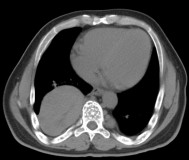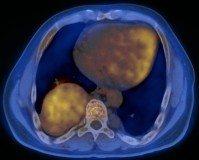Thalassemia incorporates a number of syndromes caused by genetic lesions leading to decreased synthesis of the α- or β-globin chains of HbA (α2β2). This results in anaemia, with severity dependent on the underlying mutations.
In severe β-thalassemia, marked anemia leads to increased erythropoietin secretion, with resultant erythroid hyperplasia in the marrow and sites of extramedullary hematopoiesis. As seen in this case, the expansile erythropoietic marrow invades the cortex and can impair bone growth. Extramedullary hematopoiesis may involve the liver, spleen, lymph nodes, and- as occurred in this case- produce extraosseous masses in the thorax, abdomen, and pelvis. Severe cachexia may result, as metabolically active erythroid progenitors steal nutrients from other tissues that are already oxygen starved. As demonstrated in this case, FDG uptake has been shown to be increased in the bone marrow and extramedullary sites in patients with beta-thalassamia.





